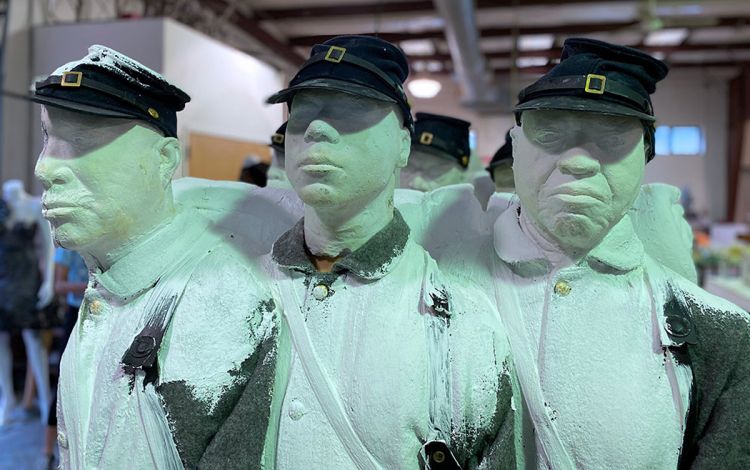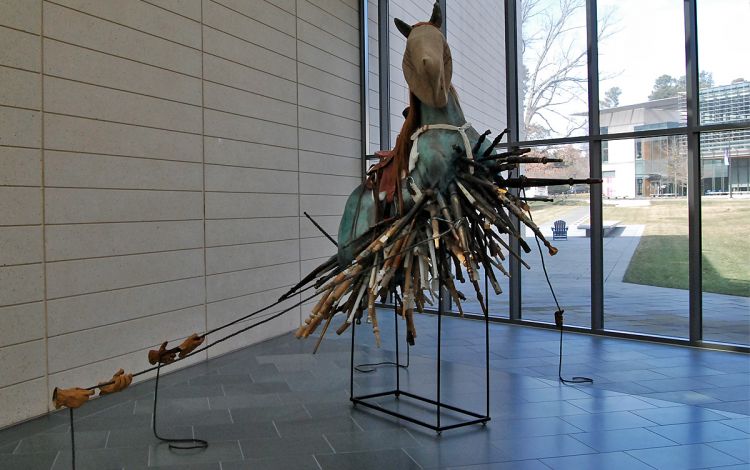Blue Devil of the Week: Creating Art that Draws on History
Assistant Professor Stephen Hayes makes art depicting the Black experience
Name: Stephen Hayes
Position: Assistant Professor of the Practice of Art, Art History & Visual Studies
Years at Duke: 3
What he does at Duke: Growing up in Durham, Stephen Hayes tinkered with materials. He took apart old, discarded equipment like printers and fax machines and turned them into art projects, using the materials to make something new.
Those early days fostered a love for art that continues in his hometown as a sculptor, mixed media artist and assistant professor in the Department of Art, Art History & Visual Studies.
Working out of a Duke sculpture studio at 406 Oregon St., Hayes teaches undergraduate and graduate-level sculpture and drawing classes. He also uses the space to work on projects such as public art pieces that give voice to the historical and contemporary experiences of Black people.
“My work comes from everyday life,” he said.
Why he creates: Hayes said he didn’t see himself in the art or artists growing up. In his art, he aims to inspire others, especially those who look like him — with works that deal with capitalism, consumerism and how the Black body is portrayed in society.
In November 2021, “Boundless,” his public sculpture, unveiled at the Cameron Art Museum in Wilmington, N.C. The exhibit honors about 1,800 Black soldiers who fought in the United States Colored Troops and marched through Wilmington near the end of the Civil War. The artwork is now a permanent part of the museum’s collection on a sliver of road where soldiers walked in 1865.
“I want to use my work as a way to change the way people view me or view somebody that looks like me,” Hayes explained. “Also, to give examples to kids who look like me about what they could do, besides what they see on television, playing ball or rapping or doing music. There are other avenues of creativity that they can go into.”
He is currently working on a public art project for Black Wall Street Gardens, a greenspace at the corner of W. Parrish St., W. Main St., and N. Mangum St. in Durham. The art will commemorate and illuminate the importance of Black Wall Street and the legacy of Durham’s African American business community.
Hayes also has a larger-than-life sculpture on display at the Nasher Museum of Art at Duke as part of the exhibition, “Reckoning and Resilience: North Carolina Art Now.”
What he loves about Duke: Hayes appreciates that Duke allows an avenue for him to combine his love of teaching with making art.
“I’m able to have some kind of input on the next generation of artists and creatives,” he said.
First ever job: Hayes made lemonade at the Chick-fil-A in the former Northgate Mall in Durham. While in high school at Camelot Academy, he worked his way up to assistant manager by age 16.
Best advice received: The late North Carolina Central University faculty member Isabel Chiquor taught Hayes to be confident when his art was done.
“Know when to stop.” Hayes recalled her saying. “When I say know when to stop, I mean know when the artwork is finished.”
Today, he hopes he can mentor his students in the same way.
“If it wasn’t for her, I probably wouldn’t be where I am today,” he said. “So, passing the torch on what she did for me is what I enjoy doing.”
Something most people don’t know about him: Hayes grew up with a reading disability that affected his experience in school. He hopes others with learning disabilities can be inspired and thrive.
“It’s all about being happy and learning what you’re great at and accomplishing it,” he said.
Lesson learned during the pandemic: The pandemic taught Hayes that his art is important and valuable.
When he wasn’t spending time with his wife, Felicia, or their 2-year-old twin boys, Brendan and Lenden, Hayes drove to the studio and enjoyed the solitude of his artwork. Much of that time was spent on “Boundless,” turning a dream into reality and continuing his life’s work.
“I love finding things and making stuff out of it,” Hayes said. “It’s all about adaptability and learning how to wow not only myself, but the audience. That’s why I love making art.”
Is there a colleague at Duke who has an intriguing job or goes above and beyond to make a difference? Nominate that person for Blue Devil of the Week.